Porcelain Insulator News
by Jack H. Tod
Reprinted from "INSULATORS - Crown Jewels of the Wire", October 1973, page 28
Preferably direct porcelain news items and questions directly to Jack H. Tod,
3427 N. 47th Place, Phoenix, Ariz. 85018. Please enclose reply stamp. All mail
will be answered, and the most newsworthy items and questions of general
interest will be published as space permits.
A LONG AND DIFFICULT TRAIL
As far as I know, not a single specimen of the insulator styles described
below has ever been turned up by any collector - and may never be. However, the
history of these designs is so interesting that I have for the past three years
spent quite a bit of effort tracking down any information about them and hope
that someday collectors may indeed turn up some specimens.
To serve as an introductory explanation of these insulator designs, I am
quoting below a portion of the section on theme from my book "Porcelain
Insulators Guide Book for Collectors".
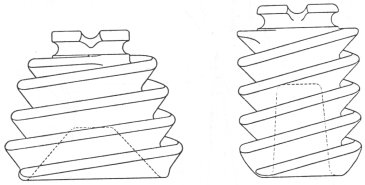
SPIRAL AND HELICAL INSULATORS
In the late 1920's, the "Spiral" insulator was conceived by Brent
Mills and Charles L. Stroup. Mr. Mills was at that time a sales engineer in
Chicago with Lapp Insulator Company, and Mr. Stroup was a transmission engineer
with Public Service Company of Northern Illinois. This first design was a pin
type, slightly conical in shape, and was thus referred to as the
"Spiral" insulator.
These men had always been greatly concerned about insulator contamination
problems, and their Spiral design was a further extension of the principles
embodied in the new Fog type insulators developed by Lapp. The outer surface of
the insulator consisted of one petticoat which spiraled from the tie-wire groove
down to the bottom of the insulator in approximately five turns, not unlike a
corkscrew. The outer edge of the spiraling petticoat was turned up (as opposed
to having a drip point) in order to make a trough for rainwater.
The reasoning was very logical; if the new Fog types were better because of
better washing and uniform surface wetting, the Spiral should be that much
better. The conical shape aided in catching the maximum amount of rainwater, and
the spiraling trough assured that the insulator would be thoroughly washed and
uniformly wetted all the way around. Lapp made some sample units which Mills and
Stroup had tested for performance. The wet flashover results were discouraging,
and the design was layed aside because they decided it had no value.
Mr. Stroup later went with Jeffery-Dewitt Insulator Company, and the design
was renewed with vigor at J-D. It is difficult to reconcile Mr. Mills' account
of the disappointing test results on the Lapp experimental samples with all the
work that Mr. Stroup did on this design at Jeffery-Dewitt; maybe they were
reading the wrong scale on the voltmeter on the early tests! In any event, J-D
made a number of units essentially identical with the first design and put them
into test service. Units removed after five years of service adjacent to a
cement plant contained considerable cement deposit in the grooves but tested
nearly as good as new units. A complete double-circuit line near a steel mill
was constructed with these units, and they were found to be remarkably clean
after nine years of service.
In the mid-1930's, both J-D and Lapp had evolved "post" type
designs of Helical insulators (vertical profile, not conical). J-D had several
such designs under test, and these had two staggered helical petticoats of four
turns each. In Brent Mills' book, a Lapp unit is pictured which has four
separate spirals of three turns each, to further increase the pitch of the
helix.
Although these Helical insulators had considerable merit, they disappeared
from the scene by 1940 in the dust trail left by the bounding "Fog
type" and "Hi-top" insulators. Those who were concerned with
their development shed some tears, but none of the other companies even sent
flowers to the Helical's funeral. The design was a victim of being an expensive
and difficult one trying to compete with cheap and easy ones. J-D was accustomed
to making their pin type insulators by the casting process, but other companies
didn't cater to this method for high production insulators that could be made
much more inexpensively by plunging and turning methods.
Only a limited number of "Spirals" and "Helicals" were
made for experimental lines. Needless to say, these units are very scarce and
are desirable in collections because of their historical nature.
The drawing of the Spiral insulator on the preceding page is one I made from
the specimen in the Lapp Insulator Co. museum at LeRoy, N.Y. This specimen is
the only one of this type I know to exist, and it could possibly be one of those
made for the initial tests about 1927. It has a cemented-in iron pin bushing
with machine threads.
The drawing of the Helical insulator is from data on a drawing I found in the
files at Lapp. The drawing date is Mar 5, 1929 (revision May 4, 1931). The
insulator No. 6974 (shown above) is a double helix version, and the similar
insulator No. 6973 is a quadruple helix.
In 1971 while searching through file cabinets of some obsolete material at
the McGraw-Edison Insulator plant (formerly Illinois Elec. Pore.), Macomb,
Illinois, I found a copy of a very detailed Jeffery-Devitt summary report on all
their development work on theme types. This included photos of Helicals under
wet flashover test and tabulated test data and conclusions reached. Also, it
included a very clear photo of the double-circuit line with six of the Spiral
insulators per pole - as mentioned in the above book excerpt.
Earlier this year I went to Kenova, West Virginia in an effort to search the
old J-D dump for any remnants of Spiral or Helical specimens. However, this
search was not possible because the property is now occupied by a large coal
tipple owned by the Ohio River Co., and I could not obtain permission to search
the old dump area at the local office there.
Robert Winkler of Michigan City, Indiana is a serious student of old pole
line construction practices, and I'm sure you have found this out from his
excellent drawings in the "Porcelain Corner" for the past two years.
He also has an excellent memory for what he has observed over the years.
Well, the line construction with the J-D Spirals looked just a bid odd to me,
so on a long shot I showed the J-D photo to Robert while in Indiana last spring.
Fantastic Luck! Robert instantly recognized this line as an old one (no longer
there) in use by the South Shore R.R. in the 1930's, and also the nearly precise
location as east of the Gary Station at Broadway.
At the next opportunity, Robert visited NIPSCO's Gary, Indiana Engineering
Dept. The Engineering Supervisor there couldn't recall anything about these
insulators but anyway they decided to pull a few "pole cards" from the
file to have a look. Again, success!
One card for the "4th Polo East of Broadway" had the following
notation:

A card for the "9th Pole East of Broadway" had the following
notations (note the 1-over-2, maybe indicating one insulator was later removed);

The penciled-in removal date had been erased when the line was rebuilt in
1954, but under one of the 54's Robert could see what might have been a 39
(1939).
This concrete information led Robert to interview Albert Cook, a member of
the South Shore R.R. line crew since 1942. Robert had gotten information from
him before and found him to be "remarkably accurate" after checking it
out further. The initial question was merely if Mr. Cook knew of any
experimental insulators once used on the NIPSCO lines at Gary, Indiana.
Yes, he did. When he came on the line in 1942, these units were still in
service and he remembers seeing them himself. He said "They were blood red
color; boy they were pretty ... there were some a real light grey color."
[I won't believe that "blood red" until I see one, and I presume the
others were the proverbial "J-D blue" used by J-D on all their
insulators rated 27 Kv and up. Jack]
Mr. Cook explained that they were designed to let the water
"spiral" down to wash the insulator clean, but that they periodically
sent the fire truck down the line to hose them off as part of the experiment. He
estimates there were only approximately 300 or less on the line.
And for the epilog, Robert quotes Mr. Cook an saying, "They seemed to be
as bad or worse than regular insulators, and they were taken down and thrown
away sometime during the war [WW II]. You [collectors] could have had all you
wanted of the damn things, but I never knew anyone would want them, and we can't
pick up everything. We have enough old junk as it is."
Robert's research isn't over. It shouldn't take a genius to figure out what
he's doing now - besides looking in the "original underbrush" along
that stretch. He is now trying to find another NIPSCO oldtimer who remembers
where they used to throw away their "junk" back "during the
war". Good luck, Robert. If you find a specimen, we'll award you the cupie
doll - and if it's a "blood red" one, we'll gold plate the cupie doll
and stud its eyes with genuine rubies.
In case you might want to put a Spiral or Helical first on your want list as
Robert and I have, I might mention that these are fairly large units. The
Helical previously pictured is 6-1/2" x 8-3/4". The Spiral one to a
very heavy one about 8" x 7". But if I could get one of these, I'd
evict something out of the room to make way for it.
It is regrettable that suitable photos can't accompany this article for the
sake of completeness. Photos by Robert of the "pole cards" and of the
Gary, Indiana test site would have been nice, but would have delayed this
article further. Also, I have lugged this typewriter to my mountain fishing
hangout to get the column done by deadline, and there in no way here to
reproduce the J-D photo of the Spirals on the test line. Sorry 'bout dat.
Jack
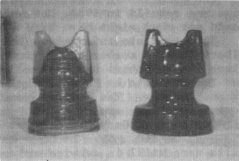
"Hello."
"Hi, Jack. This is Jerry (Jerry Turner, Goshen, Ohio)."
"What's up?"
"Jack, I just had to give you a ring. I just got
back from Washington Court House (flea market), and you will never guess what I
found up there."
"Oh, I don't know. Try me, Jerry."
"I got a porcelain JUMBO!"
"Well, Jerry, that is a little hard to believe."
"You gotta believe it. I'm sending you a snapshot of it sitting next to
my glass JUMBO. It's a whisker bigger than the glass one, but is nearly
identical except for a larger side groove."
"Is it the one with the ears or the other JUMBO?" "The one
with the ears."
"Any marking, Jerry?"
"No, but the glaze sorta smells like a Locke."
"Yeah, but that design is more like something which New Lexington would
crank out, and New Lexington glaze on many of their items resembles the early
Locke glaze. Looks like this shape will fit the porcelain Universal Style Chart
at about U-407. Can you send me a shadow profile and the measured dimensions so
we can draw it up for the next supplement to the chart?"
"Will do, Jack."
"O.K. and many thanks. Our Crown Jewels readers will probably also be
very excited over this new find. Bye."
"So long, Jack."
The porcelain insulator pictured at the right is the Lapp Insulator Co. #5399
, drawing dated Nov 4, 1924.
Although I haven't seen one of these in any collection to date, I show it
here because it's the nearest thing we have to the glass Columbia insulator. It
is a "support" insulator, and the two ear holes are for tie wire.
Anyone seen one of these?
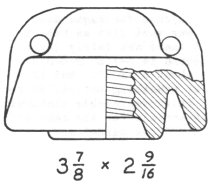
Dear Jack:
This insulator was taken off a Great Western Power Co. line about 50 miles
south of Oroville 15 years ago. There were only 3 found then. G. W. P. Co. was
absorbed by P. G. & E. Co. around 1920.
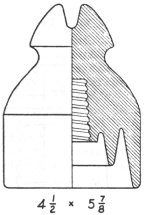
The insulator is unmarked, white, very smooth and has a "mold line"
running from the top of the side groove to the straight part of the skirt. It is
definitely not a glazeweld item.
The insulator resembles some of my "Imperials". However, I am 90%
certain that it is dry process. Even at that, it appears to be very well made in
all respects. Any clues as to age or who may have made it?
Larry Thomas,
OrovIlle, Cal.
- - - - - - -
Dear Larry:
If it were wet process, it would be either Imperial or Thomas - but Imperial
marked nearly all their production, and Thomas never cataloged a shape like
this. Being a dry process item, I would attribute this insulator to either
General Electric Co. or Peru Elec. Mfg. Co. (Peru, Ind.). Both these companies
were making "high voltage triple petticoat insulators" in the 1894-98
period, and I also feel the U-744 with this type of "mold line" was
made by G.E. or Peru. Maybe someday we'll find out.
Jack

Dear Jack:
In the May 1973 issue of Crown Jewels you answered a question by Jarl &
Karen Anderson about a knob marked WIRT. I have a porcelain insulator that fits
the "fireplug" part of your answer. It was held away from a building
by a metal bracket around the middle of the insulator. The hole goes all the way
through.
Michael Barbieri
Cornwall-on-Hudson, N.Y.
- - - - - - - -
Dear Michael:
The WIRT CO. item you have does fit the theme of patent- #477,980, June 28,
1892 - inventor Herbert C. Wirt, patent assigned to Thomson-Houston Elec. Co.,
Boston, Mass.
The "CO." in the "WIRT CO." marking intrigues me, and
this helps explain the WIRT name on the No. 1 knob in the May column. It is
possible that Mr. Wirt later started jobbing dry process porcelain insulators
himself under the name of Wirt Co.
Jack
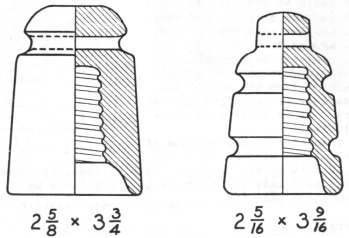
Here are two more communication pin type designs with the 1/4" hole
through the crown similar to the U-70.
The one on the left in a specimen in the collection of Jim Allen, Phoenix,
Ariz. Manufacturer is unknown.
The one on the right is shown on Ohio Brass Co. drawing #ES-3882, Jan 14,
1944. The drawing in marked "U.S. Army Signal Corps, Sim. O-B
#9400"and also has a notation "Sim. Signal Corps No. IN-26, Except For
Drilled Hole".
Hopefully now we can determine the reason for the hole in the crowns of these
insulators. I have written to a man who was working on Signal Corps items at O-B
during the war and will also attempt to get complete specs on all Signal Corps
pin types from the appropriate agency. This could answer questions we have on a
number of other special types we have been wondering about.
Dear Jack:
I am sending a sketch of an insulator that came from Huntley, Ill. and was
installed in the late 1920's according to the linemen. I can't find this shape
in the porcelain Universal Style Chart. Please let me know what you think.
Carl H. Behrens, Woodstock, Ill.

- - - - - - - -
Dear Carl:
Yes, I agree that the item you have is not exactly the same as any in the
style chart, but it is identical to the U-470 except for having a recessed
petticoat. I would suggest you catalog it as "Sim U-470, Skirt Rest".
We already have 800 different shapes in the published porcelain style chart
against only about 200 in the glass CD- chart and are naturally getting
concerned about the size of the U- chart getting out of hand. Enough radically
different pin type shapes have shown up even since the 1972 Supplement A that it
looks like 100 more new ones before the end of this-year. Thus, my present
approach tends toward excluding any more new shapes that differ from ones
already in the chart due to such details as no-dimple crowns vs. dimple crowns
and shapes identical except for recessed instead of extended petticoats or vice
versa. Such items might be included if on a more exotic shape such an helmets,
transpositions, etc. But if we kept putting these in for all the cable types,
there would be no end to the ultimate size of the chart. I continue to urge
using a liberal dose of the word "Similar" when listing item to help
get us around this problem.
(I trust that this lengthy answer will assist others, since I have received
roughly the same question possibly 50 times during the past year or so.)
Jack
Dear Jack;
Last week, at an antique shop in Illinois, I purchased a PHVI porcelain
insulator marked "Pittsburg" on the upper sloping surface of one ear.
Although the one word marking is not easy to discern, because the incuse letters
are filled and partly bordered with dark reddish brown glaze, It is definitely
the word Pittsburg. It is similar to U-710, crown as U-745, and 1" pin
hole.

The glaze characteristics and the pin hole detail are definitely like other
Pittsburg specimens. I have a second identical one from the same shop, but it
has no marking. Perhaps you or someone else has found a PHVI marked insulator by
now, other than the date-control ones.
Fred A. Hildebrand
10700 W. 26th Ave.
Lakewood, Colo. 80215
- - - - - - - -
Dear Fred:
No, this is the first report of a pin type with a "Pittsburg"
handstamp marking, and it has to be rated as a very desirable rarity. Until your
report, I would have booked money that Pittsburg never marked their name on any
of the millions of pin types they made, so we'll have to class your marking find
as one of the most important ones thus far. I hope other collectors will now be
on the lookout for this rare marking.
Jack
| 